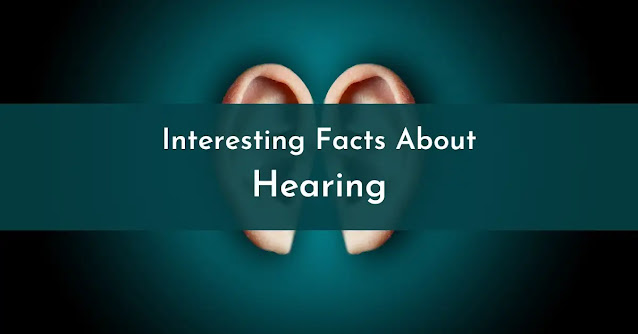Discover 25 Fascinating Facts About Hearing and Sound Perception
Hearing is a sense that we rely on to communicate with others and understand the world around us. It allows us to enjoy music, converse with friends and family, and stay aware of potential dangers.
Despite its importance, many of us take hearing for granted and fail to appreciate the intricate processes involved in sound perception. In this article, we will explore 25 interesting facts about hearing, from the anatomy of the ear to the psychological aspects of auditory perception.
25 Ear-Resistible Facts About Hearing You Need to Hear!
1. The ear is the organ responsible for hearing. It consists of three parts: the outer ear, middle ear, and inner ear. Each part has a specific role in the process of sound perception.
2. The outer ear consists of the pinna (the visible part of the ear) and the ear canal. Its function is to collect sound waves and direct them towards the middle ear.
3. The middle ear contains the eardrum and three small bones called the ossicles (the malleus, incus, and stapes). These bones transmit the vibrations from the eardrum to the inner ear.
4. The inner ear is the site of sensory transduction, where sound waves are converted into electrical signals that can be interpreted by the brain.
5. Hair cells in the inner ear are responsible for converting sound waves into electrical signals. These cells are delicate and can be damaged by loud noises, causing hearing loss.
6. Loud noises can cause hearing loss by damaging hair cells or causing them to die. This type of hearing loss is called noise-induced hearing loss.
7. Exposure to loud noises over a long period of time can also cause hearing loss, even if the noises are not extremely loud. This type of hearing loss is called age-related hearing loss or presbycusis.
8. Tinnitus is a condition in which a person hears a ringing, buzzing, or other sound in their ears. It can be caused by exposure to loud noises, ear infections, or other factors.
9. The cochlea is a snail-shaped structure in the inner ear that is responsible for detecting different frequencies of sound. Different parts of the cochlea are sensitive to different frequencies of sound, allowing us to distinguish between high and low-pitched sounds.
10. The ability to perceive high-pitched sounds declines with age. This is why older adults often have difficulty hearing the voices of children or female speakers.
11. The ability to perceive low-pitched sounds is less affected by age, which is why older adults can often still hear bass notes in music.
12. The human ear can detect sounds ranging from 20 Hz to 20,000 Hz. However, the range of frequencies that we are most sensitive to is between 2,000 Hz and 5,000 Hz.
13. Sound travels faster through denser materials, which is why it travels faster through solids than through liquids or gases.
14. The speed of sound in air is approximately 343 meters per second (1,125 feet per second) at room temperature.
15. The speed of sound is affected by temperature, humidity, and altitude. At higher altitudes, sound travels faster due to the thinner air.
16. The brain is responsible for interpreting the electrical signals sent by the inner ear. It uses a complex system of neural circuits to make sense of the sounds that we hear.
17. The brain can distinguish between different sounds even when they are presented simultaneously. This is known as the cocktail party effect.
18. The cocktail party effect allows us to focus on a single conversation in a noisy environment, even when other people are talking nearby.
19. Sound localization is the ability to determine the location of a sound source. It is made possible by the fact that sound waves arrive at the two ears at slightly different times, allowing the brain to determine the direction from which
20. Binaural beats are a phenomenon in which two different sounds of slightly different frequencies are played into each ear. The brain perceives a third sound, known as the binaural beat, which is a result of the difference in frequencies. Binaural beats are often used for relaxation and meditation.
21. Hearing impairment can have a significant impact on a person's quality of life, affecting their ability to communicate, work, and socialize. It can also lead to feelings of isolation and depression.
22. Hearing aids are devices that can help people with hearing loss by amplifying sound. They come in a variety of styles and can be custom-fitted to the individual's ear.
23. Cochlear implants are electronic devices that can provide a sense of sound to people with severe hearing loss or deafness. They bypass the damaged hair cells in the inner ear and directly stimulate the auditory nerve.
24. Noise-induced hearing loss is a preventable condition. Wearing earplugs or earmuffs in loud environments, such as concerts or construction sites, can help protect against hearing damage.
25. In addition to its role in sound perception, hearing also plays an important role in balance and spatial orientation. The inner ear contains structures known as the vestibular system, which are responsible for detecting changes in head position and movement.
Hearing is a fascinating sense that allows us to interact with the world around us. From the delicate anatomy of the ear to the complex processes involved in auditory perception, there is much to discover about this essential aspect of human experience.
Understanding the science behind hearing can help us appreciate its importance and take steps to protect and enhance our hearing abilities. Whether we are enjoying music, engaging in conversation, or simply experiencing the sounds of nature, hearing enriches our lives in countless ways.


No comments:
Post a Comment